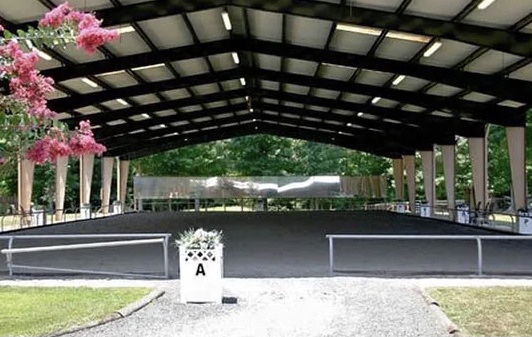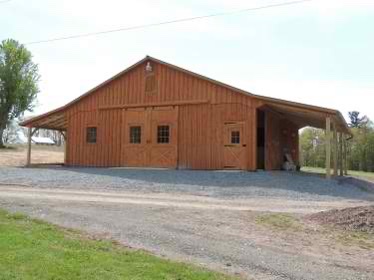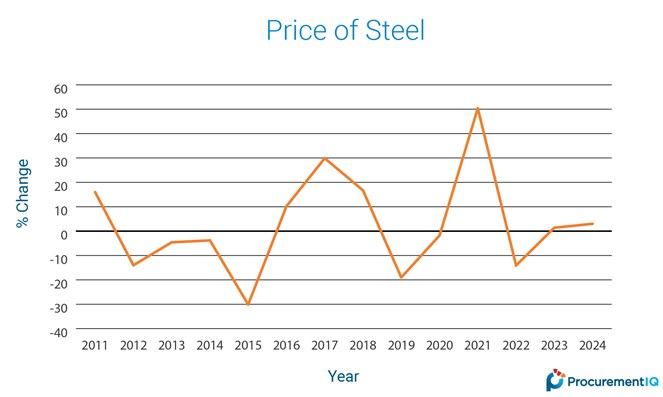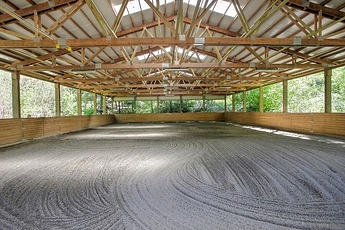What is the height of your sidewalk in your indoor? I’ve seen recommendations for everything from 14 to 20. I don’t want it to feel claustrophobic, but of course every foot adds $$
Around here standard is 16’ minimum and for roping 18’.
Some even go 20’, but that is not required for anything we may do with horses.
There is one local roping barn that has trusses at 15’ and ropers complain is just a bit too short.
Our covered arena is clear span framed, not trusses.
Sides are 18’, the middle is 26’, on a 2/12 pitch.
Different ways of building arenas, trusses are generally manufactured in a shop and hauled and with a crane put on posts.
Framing as clear span you have beams engineered to support the roof against the posts.
Both ways are as good as the engineering, fabricating and installing is.
Internet sourced pictures, first manufactured trusses, second clear span framing:

14 feet. There’s a set of 6’ jump standards in there, and I would say jumping 5’ would be okay. (The odds of me ever jumping 3’6" is pretty small!) When I was planning my arena I studied the one at the boarding barn and I’m pretty sure it was 14 foot and it had a dropped ceiling. That didn’t feel claustrophobic, nor does mine that is open to the roof. And as Bluey is showing, if you have clear span, only the edges are the minimum height.
Clear span vs trusses is a good point. 14’ seems awfully low to me, especially for jumping, but I guess it could be okay if clear span.
I’ve typically heard minimum 16’ for flatting, 18’+ for jumping.
Thank you! This was helpful to visualize. I definitely think I need taller if it’s trusses, but I’m hoping for clear span.
Do you have a pic by chance?
I had one company come back to me saying I only needed 14 or 16 feet, but that just seems so low to me.
This is what I thought too. I asked for 20 because I wanted to make sure it felt nice and open, but one company came back and told me they wouldn’t do over 18 and they usually did 14 or 16
Maybe 20’ is not necessary, especially if you will have a clear span interior, no trusses?
Could you go check local barns like you are building, see what dimensions you like best, maybe some your builder put up?
Something else to consider, if you have now or want to add overhangs later, the lower the less width you may have for the overhang before it gets too low in front of it for horses.
Here are some pictures showing overhangs built on the side and how the initial height by the barn will limit how far out you can build and still have good height in front:

Good point on the overhangs. No plans on building those right now but you never know.
I definitely will be once I choose the builder. I’ve gotten some insane quotes and some really good ones so far.
I was thinking of getting one with the jumps in there, just need to get out there with my phone. Then remember how to post it on here!
I had never heard of 18 feet before, other than Bluey saying it for roping (in other previous threads.) Always heard 16 feet for jumping but totally unnecessary in my case.
I suspect the reason is OSHA requirements " fall protection must be provided for employees climbing or working on fixed ladders above 24 feet."
20ft side walls would most likely make the crest of the roof over the 24 foot height
Interesting point, didn’t think of that
Hopefully the link works.=> Not sure why you have to click on one and the other appeared…
IMG_20210726_124422611|375x500
The top bar on the silver jump is set at 5 ft and it’s trying to blend in with the board on top of the kickboard.
Thank you, that really helps!
I suspect the reason is OSHA requirements " fall protection must be provided for employees climbing or working on fixed ladders above 24 feet. "
20ft side walls would most likely make the crest of the roof over the 24 foot height
We used approved fall protection, a line from a light harness to the side rail of the working cage we built to reach the middle height to bolt beams together up there.
Ours was 26’ at the peak on 18’ eaves at 2/12 pitch.
Then we were not “on ladders” at that height?
Like anyone doing any such work, we followed way more security rules than OSHA regulations demand as the minimum legally necessary.
I doubt following that OSHA regulation would keep someone from building a bit higher?
there are contractors who do want limit their exposure therefore decline projects or aspects of projects.
My company never dug the pits for the anti-terrorist crash barriers because we did not have the shorting required (nor excavator that could be rented) Our expertise was making it work in the desired way
there are contractors who do want limit their exposure therefore decline projects or aspects of projects.
My company never dug the pits for the anti-terrorist crash barriers because we did not have the shorting required (nor excavator that could be rented) Our expertise was making it work in the desired way
Right, why is important to get the kind of company that can do what we need done.
If they tend to work most with trusses, guess what they will want to use.
If with clear span framing, well, same.
A height of 14’ on trusses is not the same as that 14’ on clear span, that gives you so much more head room inside, maybe better for a horse arena, without needing to go so high on the sides.
The OP will have to ask all the questions, then decide what may work best for her.
The OP will have to ask all the questions,
and there are many questions that need to be asked and the answers need to be verified
May come down to where steel vsv lumber prices are at the moment you’re ready to commit. Whatever you do, I would try hard to time that purchase to early 2022, even if means buying several months in advance of the actual build. Once this infrastructure bill starts turning into actual projects, steel and lumber both are gonna get ugly.

In my area, most of us homeowners who built arenas have 16 foot walls (trusses) for jumping and it’s fine. I think 14 would be fine for flat, but it would feel low to me. 18 or 20 seems like overkill. Better to use the $$$ to make arena longer and/or wider for jumping.




